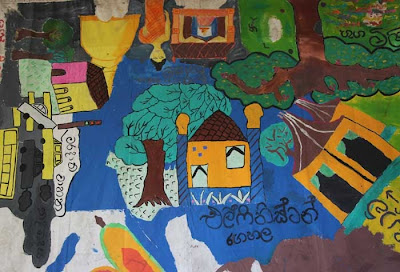This is about how kids in a number of localities in Sri Lanka see the world around
them; the natural environment, ‘important’ people in their midst, temples, churches, theatres,
stores owned by local people etc. These are pictorial maps as they see them and drawn by them,
devoid of the nastiness of the adult world rapidly going mad around them. They
see the temples as they see churches; they are simply places of worship; no
seeming structures of hierarchy. May be there is some hope, at least until they
become adults and join the madness around them.
This is what the adults who conceptualized the program and exhibition say
about their effort: Theertha
International Artists Collective, Colombo in collaboration with Barefoot
Gallery, Colombo is presenting 'Ape Gama', an art exhibition that traces a
series of Theertha programs undertaken in the past three years which combines
art and heritage management. Theertha is an artists' collective working to
facilitate contemporary art discourses within the art community in Sri Lanka. Initiated first in Kamburupitiya, Horapavita
in 2009 by Theertha, the program 'Ape Gama' (Our Village) incorporated art
workshops with school children, training sessions for teachers of art and
discussions with community leaders on heritage management as integral parts of
its work process. Through a holistic
approach, 'Ape Gama' program facilitated the community to rediscover its own
heritage present within its own area. In
2010 and 2011, 'Ape Gama' program (Let’s Take a Walk) was held in
Maradana and Gampaha. At the end of all
three programs, a map marking the rediscovered heritage sites within these
specific local areas were drawn by school children that was enlarged,
printed and distributed. The uniqueness
of the 'Ape Gama' program lies in its ability to combine art and heritage
management as a potent tool to mobilize communities to rethink about their own
heritage giving attention to elements of contemporary popular cultural
dynamics.
The 'Ape Gama' program is conceptualized on the
basis of a different understanding of heritage from that of the dominant Authorized Heritage Discourse
(The guiding principles of heritage preservation in Sri
Lanka, as in many other countries are founded on the established notions of
heritage preservation rooted in the western discourse of heritage, which Laura
Jane Smith (2006) has labeled as the
Authorized Heritage Discourse.)[1]. Here, heritage is seen as a cultural process
rather than as a fixed entity while it is also is seen as a way in which a
community connects and associates with what is regarded as heritage. This
project intends to show that culture and heritage are contemporary experiences
and that they do not merely belong to the past.. At the same time, situations
that would be singled out as worthy of preserving and contemplation will be
presented not simply as traces from the past, but more as traces of a larger
social and cultural network that endows and constitute collective memories and
identities of the village as a complex expression. The program prompts villagers
or local residents of a specific locality to give value to the heritage
expressions/situations that are both natural and cultural in their own localities
both in terms of their specificity and inclusivity. In the course of the
program, it was hoped that villagers will come to understand and appreciate the
connectedness of their particular village, in terms of its heritage
expressions/situations, to a larger geo-political region and to a deeper and varied
socio-historic times.
The exhibition 'Ape Gama' will present selective
documentation of the programs held in Horapavita, Maradana and Gampaha. 'Ape Gama' will be on show from 11th
to 28th July 2013 at Barefoot Gallery, Galle Road, Colombo 4.
[1] The guiding principles of heritage preservation in Sri
Lanka, as in many other countries are founded on the established notions of
heritage preservation rooted in the western discourse of heritage, which Laura
Jane Smith (2006) has labelled as the
Authorized Heritage Discourse.
















